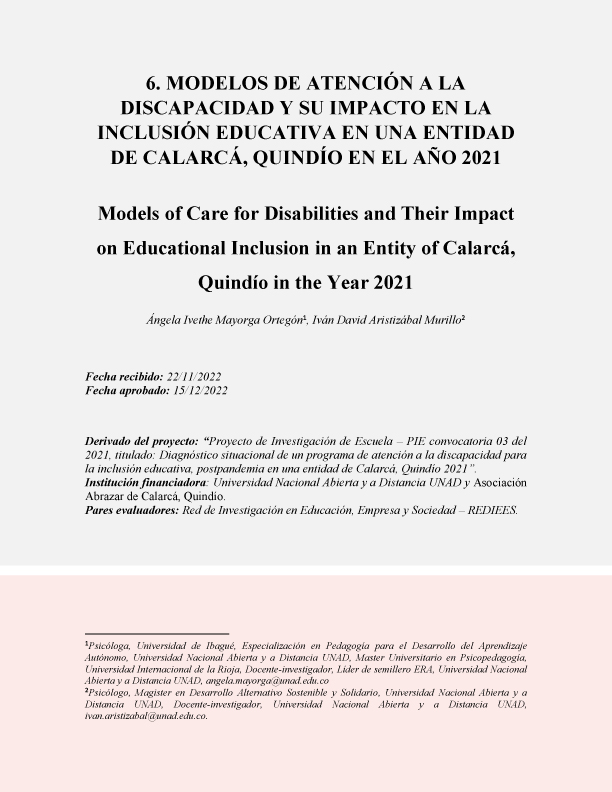VI. DISABILITY CARE MODELS AND THEIR IMPACT ON EDUCATIONAL INCLUSION IN AN ENTITY OF CALARCÁ, QUINDÍO IN THE YEAR 2021
##plugins.themes.bootstrap3.article.main##
Abstract
SUMMARY
Taking into account the relevance that talking about educational inclusion in formal and non-formal academic systems has today, this approach is carried out that allows establishing a description of the disability care models and their impact on educational inclusion in an entity from Calarcá, Quindío in 2021, in order to expand the academic discussion, to influence the circumstances in the living conditions of people who are in quality and/or condition of disability and who, in some way they face different barriers to their full development; Hence, the research process is based on an empirical-analytical position that seeks to describe the phenomenon in a qualitative way, thus facilitating the relational identification between the care model and educational inclusion with respect to disability. Thus, it is evident through the application of the different analyzes that the curricular construction of the programs that address disability lacks an adaptation that allows addressing the real needs of individuals with a condition or quality of disability, because they do not have a defined care model. From the above, and by way of conclusion, it is important to recognize that the lack of regulations that encourage educational entities to adopt models of care that allow real educational inclusion and that break the paradigms of purely social inclusion, new spaces are needed. research and academic discussion.
Download Statistics
##plugins.themes.bootstrap3.article.details##
inclusion; disability; educational inclusion; Model of attention; quality of life.
Ainscow, M. (2001). Comprendiendo el desarrollo de las escuelas inclusivas. Facultad de Educación de Manchester.
Andalucía Solidaria. (2020). Inclusión Social. https://bit.ly/3PgMqqm
Arenas, A., Castellanos, G., Castiblanco, D. y Mayorga, A. (2019). Barreras actitudinales en la discapacidad auditiva: el estigma y la exclusión como semillas de la guerra. Centro de investigación y acción psicosocial comunitaria: un escenario para la construcción de paz (pp. 162-188). Sello editorial UNAD
Aristizábal, I., Diaz, A. y Mejía, J. (2021). Una aproximación a la incertidumbre sobre el futuro en adolescentes escolarizados del Municipio de Finlandia (Quindío). Investigación Científica Multidisciplinaria (pp. 107-124). Editorial EIDEC.
Ceron, E, Y. (2015). “Educación Inclusiva” una mirada al modelo de gestión de la Institución Educativa Departamental General Santander sede Campestre. [Tesis de pregrado]. Repositorio Universidad Libre. https://bit.ly/3Wa2kVD
Dávila Sguerra, M. (2020). Ciencias satelitales e inclusión social. ACIS, (157). 75-85. https://bit.ly/3W3Bqyw
Departamento Nacional de Planeación DNP. (2013). Conpes Social 80. Política Pública Nacional de Discapacidad e inclusión Social. https://bit.ly/3VH9yAF
Jiménez Rodríguez, M. y Ortega Valencia, P. (2018). Referentes sobre inclusión educativa para personas con discapacidad: líneas para pensar su potencial en el ámbito escolar 1. Civilizar Ciencias Sociales y Humanas, 18(34), 85-100. https://doi.org/10.22518/usergioa/jour/ccsh/2018.1/a06
Mayorga, A., Méndez, C. y Buenaventura, J. (2020). De la educación inclusiva a la inclusión por el saber. Visibilizar las (dis)capacidades. Experiencias cotidianas de trabajo con población diversa. (pp. 127-145). Arkho Ediciones. http://editorialabiertafaia.com/pifilojs/index.php/FAIA/article/view/176/211
Molina, R. (2010). Educación superior para estudiantes con discapacidad. Revista de Investigación, 34(70), 95-115. https://bit.ly/3Hrdscu
Departamento de Derecho Internacional (2004). Convención Interamericana para la Eliminación de todas las formas de Discriminación contra las Personas con Discapacidad. https://www.oas.org/juridico/spanish/tratados/a-65.html
Organización de las Naciones Unidas. (13 de diciembre de 2006). Convención sobres los Derechos de las Personas con Discapacidad PcD. https://www.un.org/esa/socdev/enable/documents/tccconvs.pdf
Padilla-Muñoz, A., (2010). Discapacidad: contexto, concepto y modelos. International Law: Revista Colombiana de Derecho Internacional, (16), 381-414. https://bit.ly/3Ydq9xF
Ministerio de Educación Nacional (octubre 24, 2003). Resolución 2565 de 2003. Por la cual se establecen parámetros y criterios para la prestación del servicio educativo a la población con necesidades educativas especiales. DO. 45.357. https://bit.ly/3W6T1pA
Sabando Rojas, D. S. (2016). Inclusión educativa y rendimiento académico. Relación entre el Grado de Inclusión y el Rendimiento Académico en las Escuelas Públicas de Primaria de Cataluña. [Tesis doctoral]. Repositorio Universitat de Barcelona. https://bit.ly/3FknOIz





